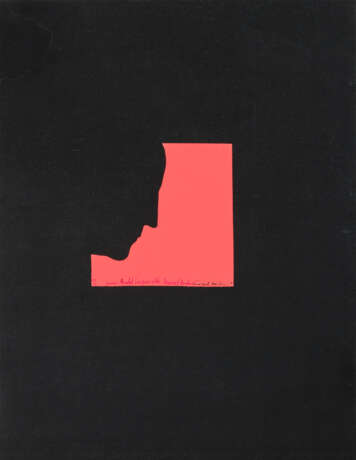ID 991154
Lot 165 | DUCHAMP, Marcel (1887-1968)
Estimate value
€ 20 000 – 30 000
Affiche sérigraphiée d'après l'Autoportrait de Profil. [Paris : Trianon Press, 1959].
L'affiche de l'exposition "Sur Marcel Duchamp", reprenant son Autoportrait de profil, cet exemplaire avec envoi autographe signé de Duchamp à son éditeur Arnold Fawcus : "pour Arnold imprévisible, Marcel Duchamp".
Cette affiche est réalisée pour l'exposition donnée à Paris à la librairie La Hune, du 5 au 30 mai 1959, à l'occasion de la publication de la monographie de Robert Lebel Sur Marcel Duchamp, publiée par Arnold Fawcus. Le tirage de luxe comprenait des originaux de Marcel Duchamp, parmi lesquels un collage Autoportrait de profil, repris ici en plus grand format et sérigraphié. Il s'agit de la version dépourvue de texte, n'indiquant ni le titre, ni la date, ni le lieu de l'exposition. On y retrouve la signature imprimée "marcel déchiravit", faisant allusion au procédé utilisé par l'artiste pour créer l'Autoportrait de profil.
Fondateur de Trianon Press, l'éditeur anglais Arnold Fawcus rencontre Marcel Duchamp par l'intermédiaire de l'artiste et mécène William Copley, qui lui propose de financier pour moitié un livre autour de l'artiste de son choix entre Marcel Duchamp et Max Ernst. Fawcus choisit Duchamp, marquant le début d'une aventure éditoriale mouvementée, entre retards, problèmes techniques pour les reproductions en couleurs et soucis de traduction pour l'édition américaine. C'est au cours de ce projet que les deux hommes apprennent à se connaître, comme le rapporte Julie Fawcus, épouse et collaboratrice de l'éditeur : "Arnold worked with him on the design of the de luxe book, which changed and expanded over the years. The two ‘originals’— Duchamp coloravit (Le Grand Verre) and Duchamp dechiravit (the profile) were not part of the original plan. And Duchamp was charming. It would have been difficult not to have a good relationship with him. He was very intelligent, very smooth, with a keen sense of humour. He could distance himself—step back from his own life and organize it from the outside. Like a chess player, calculating five or six moves ahead."
L'envoi taquin de Duchamp témoigne des tensions avec l'éditeur, notamment au sujet du retard de parution du livre, imputable en grande partie à la tendance de Fawcus à la procrastination, voire à disparaître pendant plusieurs jours : "Of course there were some furious letters from everyone—Duchamp, Lebel, Copley, Barney Hodes, Copley’s lawyer—during the last year and a half before the book actually came out—complaining that it was late." (Julie Fawcus)
Schwarz, n° 565 ; J. Fawcus, J. Randall, Julie Fawcus: Recollections of Trianon Press, 1996, pp. 24-27.
650 x 500 mm. Tirage sans texte (sans le titre, le lieu et la date de l'exposition) limité à 40 exemplaires en bleu et 30 exemplaires en rouge, plus quelques exemplaires hors commerce, celui-ci justifié 0/0 par l'artiste, avec envoi autographe signé de Marcel Duchamp à l'encre rouge. Sérigraphie en rouge sur papier cartonné noir, avec la signature imprimée "Marcel déchiravit". Cadre. (Habile restauration au coin supérieur gauche.)
Provenance : Arnold Fawcus (1917-1979 ; envoi)
L'authenticité de cette oeuvre a été confirmée par l'Association Marcel Duchamp. Un certificat sera remis à l'acquéreur.
Silk-screen poster after Self-Portrait in Profile for the exhibition "Sur Marcel Duchamp", organized to celebrate the publication of Robert Lebel's monography on the artist. This copy is signed and inscribed by Duchamp to his editor Arnold Fawcus, whom he describes as "unpredictable" ("imprévisible"), alluding to his tendency to procrastinate — and sometimes disappear — that caused much delay to the publication of the book.
| Place of origin: | France |
|---|---|
| Category: | Art prints |
| Place of origin: | France |
|---|---|
| Category: | Art prints |
| Address of auction |
CHRISTIE'S 9 Avenue Matignon 75008 Paris France | ||||||||||||||
|---|---|---|---|---|---|---|---|---|---|---|---|---|---|---|---|
| Preview |
| ||||||||||||||
| Phone | +33 (0)1 40 76 85 85 | ||||||||||||||
| Fax | +33 (0)1 40 76 85 86 | ||||||||||||||
| Conditions of purchase | Conditions of purchase | ||||||||||||||
| Shipping |
Postal service Courier service pickup by yourself | ||||||||||||||
| Payment methods |
Wire Transfer | ||||||||||||||
| Business hours | Business hours
|



